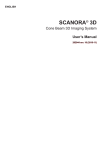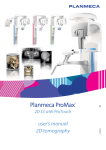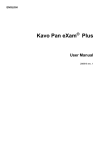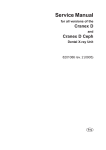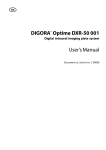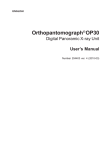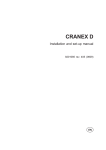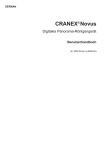Download CRANEX D - Dental Concepts
Transcript
CRANEX D Digital Panoramic and Cephalometric X-ray Unit (Version 3) User’s Manual Number 203371 rev. 1 (0812) EN Cranex D Cranex D Digital Panoramic and Cephalometric X-ray Unit (Version 3) User’s Manual Medical Device Directive 93/42/EEC Number 203371 rev. 1 (0812) Original approved English language version Manufactured by SOREDEX Nahkelantie 160, Tuusula P.O. BOX 148 FI-04301 Tuusula, Finland Tel. +358 (0)45 7882 2000 Fax. + 358 9 701 5261 User‘s Manual 203371 i Cranex D Soredex endeavours to produce product documentation that is accurate and up to date. However, our policy of continual product development may result in changes to products that are not reflected in the product documentation. Therefore, this document should not be regarded as an infallible guide to current product specifications. Soredex maintains the right to make changes and alterations without prior notice. ii User’s Manual 203371 Cranex D Contents 1. Introduction ....................................................................................................... 1 1.1 Cranex D digital X-ray unit ............................................................................. 1 1.2 About this manual .......................................................................................... 1 2. Unit description ................................................................................................ 2.1 Cranex D ...................................................................................................... 2.2 Optional cephalometric device ...................................................................... 2.3 Control panel ................................................................................................. 2.4 User interface ............................................................................................... 2.5 Accessories .................................................................................................. 2 2 3 4 5 6 3. Taking Panoramic Exposures ......................................................................... 7 3.1 Preparing the PC .......................................................................................... 7 3.2 Preparing the Unit ......................................................................................... 8 3.3 Taking a panoramic exposure ....................................................................... 9 Selecting the panoramic program ............................................................... 9 Positioning the patient for a panoramic exposure ..................................... 10 Taking a panoramic exposure ................................................................... 15 After taking a panoramic exposure ........................................................... 17 3.4 Taking a temporomandibular joint exposure ................................................. 18 Selecting the TMJ program ....................................................................... 18 Positioning the patient for TMJ exposures ................................................ 18 Taking TMJ exposures .............................................................................. 19 After taking TMJ exposures ...................................................................... 22 3.5 Taking a sinus exposure .............................................................................. 23 Selecting the sinus program ..................................................................... 23 Positioning the patient for a Sinus exposure ............................................. 23 Taking a Sinus exposure ........................................................................... 25 After taking a Sinus exposure ................................................................... 26 4. Taking cephalometric exposures (Ceph option) .......................................... 27 4.1 Preparing the PC ........................................................................................ 27 4.2 Preparing the unit ........................................................................................ 27 4.3 Taking a cephalometric exposure ................................................................ 28 Selecting the cephalometric program ....................................................... 28 Positioning the patient .............................................................................. 29 Taking an exposure .................................................................................. 31 After exposure .......................................................................................... 33 User‘s Manual 203371 iii Cranex D 5. Carpus exposures (Not in USA) .................................................................... 34 6. Using the unit without x-rays......................................................................... 36 7. Attaching and removing the CCD sensor ..................................................... 37 7.1 Attaching the sensor .................................................................................... 37 7.2 Removing the sensor .................................................................................. 38 8. Exposure switch lock ..................................................................................... 39 8.1 Unlocking the exposure switch ..................................................................... 39 8.2 Locking the exposure switch ....................................................................... 39 9. Unit setup ........................................................................................................ 40 9.1 Setup options .............................................................................................. 40 9.2 Image Preview ............................................................................................ 42 10. Troubleshooting and maintenance ............................................................. 44 10.1 Error messages ........................................................................................ 44 User Errors ............................................................................................... 44 Unit Errors ................................................................................................ 47 Other operating problems ......................................................................... 49 10.2 Care and Maintenance .............................................................................. 50 Cleaning and disinfecting the unit ............................................................. 50 Enamelled surfaces ........................................................................ 50 Positioning mirror and light lenses .................................................. 50 Surfaces that the patient touches .................................................... 50 Correct operation of the unit...................................................................... 50 Yearly maintenance .................................................................................. 51 Disposal ................................................................................................... 51 11. Warnings and precautions ........................................................................... 52 Appendix A - Technical Information ............................................................... A - 1 A.1 Technical specifications ........................................................................... A - 1 A.2 Unit dimensions ....................................................................................... A - 6 A.3 Symbols that appear on the unit ............................................................... A - 7 iv User’s Manual 203371 Cranex D 1. Introduction 1. Introduction 1.1 Cranex D digital X-ray unit The Cranex D is a digital dental x-ray unit designed to take images of the dento-maxillo-facial complex of the human skull. It can be used to take: - adult panoramic exposures, - child panoramic exposures (reduced width and height), - partial panoramic exposures - sinus exposures, - and TMJ exposures. An optional cephalometric device allows ceph and carpus (not USA) exposures to be taken. Both the unit and the cephalometric device use CCD sensors as the image receptor and a PC with the User Interface and suitable dental imaging software, such as Digora for Windows (not in USA), to handle the digital dental images. 1.2 About this manual This manual describes how to use the Cranex D digital dental x-ray unit and the optional cephalometric device. Please read these instructions and the Warnings and Precautions in section “11. Warnings and Precautions”, before operating the unit. NOTE: Instructions starting with PC: for example: “1. PC: Open a patient card” indicate that the task is carried out from the PC. Instructions NOT starting with PC: for example: “3. Close the head supports” indicate that the task is carried out from the UNIT. User ‘s Manual 203371 1 2. Unit description Cranex D 2. Unit description 2.1 Cranex D 2 User’s manual 203371 Cranex D 2. Unit description 2.2 Optional cephalometric device User’s manual 203371 3 2. Unit description Cranex D 2.3 Control panel Either the control panel or the user interface (2.4) can be used to select the imaging programs and exposure factors. Program selection keys Adult panoramic 85 Child panoramic kV KV selection keys 81 77 Temporomandibular joint 73 Cephalometric Lat / PA 70 66 Ceph. reduced width Lat T X-rays OFF key 63 60 57 Partial panoramic keys Exposure indicator READY indicator Info key Exposure time selection keys E mA s D L S+ S- Info display Up/Down adjustment keys (Z-movement) 4 Z Y mA display Exposure values display S = Exposure time (sec) 2 D = Dose (mGycm ) L = Focal trough position (mm) in PIO position Focal trough adjustment keys (Y-movement) RETURN key User’s manual 203371 Cranex D 2. Unit description 2.4 User interface Cranex D - x “Always on top” key 85 kV 81 77 73 70 66 T 63 60 57 ! 10.0 mA S+ 10.8 s S- 1.3 mGycm Error code display 2 Info key Scroll up/down keys User’s manual 203371 ! E 7 rEL 5 2. Unit description Cranex D 2.5 Accessories Chin rest - 9802612 Disposable cover for chin rest - 6801140 Bite block - 6811860 Disposable cover for bite block - 6801120 Lip support - 6811880 Disposable cover for lip support - 6801130 Lip holder - 6811870 Disposable covers for cephalometric ear cones - 6801150 6 User’s manual 203371 Cranex D 3. Panoramic Exposures 3. Taking Panoramic Exposures 3.1 Preparing the PC 1. PC: Switch on the PC that is connected to the unit. 2. PC: Open the dental imaging software and then open a new or existing patient card for the patient. For information on how to do this refer to the user’s guide supplied with the dental imaging software. NOTE: PC: If you wish to use the User Interface to select the program and exposure factors, click the CRANEX D Gui icon to open the User Interface. Cranex D User’s manual 203371 PC: If you want the User Interface Window to remain visible, and always on top of other windows, click the “Always on top” key. 7 3. Panoramic Exposures Cranex D 3.2 Preparing the Unit 1. Attach the CCD sensor to the sensor holder on the rotating unit if it is not already attached. For information on how to attach and remove the CCD sensor, see section “7 Attaching and removing the CCD sensor”. 2. Press the ON / OFF switch, on the rear, right-hand side of the unit, to the on position (I) to switch the unit on. The unit will carry out a self test during which the display lights will come on. 3. Press the RETURN key to drive the rotating unit to the patient-in-out (PIO) position. The READY light will come on and rotating unit will automatically move to the 0 mm focal trough position. s D L If the READY light does not come on refer to section “10.1 Error messages”. 8 User’s manual 203371 Cranex D 3. Panoramic Exposures 3.3 Taking a panoramic exposure Selecting the panoramic program S+ S- 1. Select the exposure time you require. Press the S+ key for the fast exposure time or the S- key for the standard exposure time. The selected exposure time will appear on the exposure values display. NOTE: When the unit is in the PIO position the exposure time will only appear briefly on the display when an S key is pressed. 2. Select the required panoramic program. The programs are: Adult panoramic - magnification 1.34 Exposure time; standard 17.6 s or fast 11 s. Child panoramic - magnification 1.34 Exposure time; standard 13.8 s or fast 8.6 s. Partial panoramic exposures - magnification 1.34 Select the Adult panoramic program. All the partial panoramic indicator lights will come on. Select the first sector you wish to expose. The indicator light for this sector will stay on and all the other sector lights will go out. Select the other sectors you wish to expose. Exposure times; standard, 3.1 s - 4 s - 7.6 s - 4 s - 3.1 s or fast, 1.9 s - 2.5 s - 4.8 s - 2.5 s - 1.9 s User’s manual 203371 9 3. Panoramic Exposures Cranex D Positioning the patient for a panoramic exposure NOTE: If the patient appears nervous you may want to reassure the patient by demonstrating how the unit works. To do this see section “6. Using the unit without xrays”. 1. Slide the chin rest on to the holder at the front of the patient handles (A). If the patient is DENTATE slide the bite block into the chinrest (B). If the patient is EDENTULOUS slide the lip holder into the chin rest. 2. Place the appropriate disposable covers on the chin support you are using. 10 User’s manual 203371 Cranex D 3. Panoramic Exposures 3. Ask the patient to remove any spectacles and false teeth and any jewellery or metal objects from their face, ears or neck. Also ask them to remove any hair clips or pins. 4. Place a protective lead apron over the patient’s shoulders. Z 5. Press the height adjusting keys to adjust the height of the chin support until it is slightly higher than the patient’s chin. 6. If the patient is DENTATE ask them to grasp the patient handles, place their chin on the chin rest and bite the bite block. The biting edges of the patient’s upper and lower incisors must be positioned in the respective notches in the top and bottom of the bite block. If the patient is EDENTULOUS ask them to place their chin on the chin rest and press their top lip against the lip holder. User’s manual 203371 11 3. Panoramic Exposures Cranex D 7. Open the mirror so that you can see a reflection of the patient in the mirror. The patient positioning lights will come on. NOTE: The lights will remain on for 30 seconds. If you need more time briefly press one of the focal trough light adjusting keys. Y 8. Look at the reflection of the patient in the mirror and position the midsagittal plane of the patient so that it coincides with the midsagittal plane light. The patient’s head must be positioned symmetrically and the patient must be looking straight ahead. The patient’s head must NOT be tilted or turned to one side. 12 User’s manual 203371 Cranex D 3. Panoramic Exposures Z 9. Press either height adjusting key to adjust the tilt of the patient’s head until the patient’s Frankfort plane coincides with, or is parallel to, the horizontal light. 10. Close the temple supports by moving the temple support knob to the right. Make sure that patient’s neck is stretched and straight. 11. The focal trough light indicates the center of the focal trough, which is 15 mm wide at the front. The root apices of the patient’s central upper and lower front incisors must be within the focal trough. Ask the patient to open their lips so that you can see their teeth. The focal trough light should be positioned slightly in front of the root apices, which for most patients will be between the upper 2nd tooth (lateral incisor) and upper 3rd tooth (canine) when the focal trough position is 0 mm. s D L User’s manual 203371 13 3. Panoramic Exposures Cranex D If the patient is edentulous the focal trough light should be approximately 5mm behind the lip holder when the focal trough position is 0 mm. Y NOTE: If the focal trough light is not positioned as described above, press the focal trough adjustment key(s) to move the focal trough light until it is positioned correctly. s D L 12. Carefully push the forehead support in until it touches the patient’s forehead or nasion. 13. Close the mirror. 14 User’s manual 203371 Cranex D 3. Panoramic Exposures Taking a panoramic exposure 1. Check once more that the patient has not moved and is positioned correctly for a panoramic exposure. 2. Press the RETURN key to drive the rotating unit to the START position. Make sure that the READY light is on. If it is not refer to section “10.1 Error messages”. 85 kV 81 User’s manual 203371 The kV value, based upon the size of the patient’s head, will be automatically selected. IMPORTANT NOTE: The rotating unit must be in the START position (press the RETURN key) for the kV value to be automatically selected. If the rotating unit is not driven to the START position the kV value will NOT be automatically selected and the kV value that was used for the previous exposure will be selected. 15 3. Panoramic Exposures 85 kV Cranex D 3. If you wish to change the kV, select a different value. 81 4. Before taking a panoramic exposure ask the patient to press their lips together and press their tongue against the roof of their mouth. Also ask the patient to look at a fixed point in the mirror and to remain still for the duration of the exposure. 5. Move at least two metres from the unit and protect yourself from radiation. Make sure that you can see and hear the patient during the exposure. 6. Press and hold down the exposure button for the duration of the exposure. During the exposure you hear the audible signal and the radiation warning light on the display will come on. The rotating unit will rotate around the patient’s head and then stop. When the rotating unit stops, the exposure has been taken. 16 User’s manual 203371 Cranex D 3. Panoramic Exposures After taking a panoramic exposure 1. Open the temple supports and press the button to release the forehead support. 2. Guide the patient out of the unit. 3. Press the RETURN key to drive the unit to the PIO position. 4. PC: The digital image can now be examined using Digora for Windows (not in USA). User’s manual 203371 17 3. Panoramic Exposures Cranex D 3.4 Taking a temporomandibular joint exposure Selecting the TMJ program 1. Select the Temporomandibular joint program magnification 1.34. Positioning the patient for TMJ exposures NOTE: If the patient appears nervous you may want to reassure the patient by demonstrating how the unit works. To do this see section “6. Using the unit without xrays”. IMPORTANT NOTE: You must take TWO separate exposures if you wish to have images of the TMJs with the mouth open and closed. 1. Slide the lip support on to the holder. Place a disposable cover on to the lip support. 2. Prepare the patient in the same way as you would for a PANORAMIC exposure. 3. Open the mirror and position the patient as follows: - top lip pressed against the top of the lip support. - midsagittal plane coincides with the midsagittal plane light. 18 User’s manual 203371 Cranex D 3. Panoramic Exposures - focal trough light in the same position as for panoramic exposures, between the upper 2nd tooth (lateral incisor) and the 3rd tooth (canine). - frankfort plane coincides or is parallel with the horizontal light. 4. Close the temple supports by moving the temple support knob to the right, and carefully push the forehead support in until it touches the patient’s forehead or nasion. 5. Close the mirror. Taking TMJ exposures 1. Check once more that the patient has not moved and is positioned correctly for a TMJ exposure. 2. Press the RETURN key to drive the rotating unit to the START position. User’s manual 203371 19 3. Panoramic Exposures Cranex D Make sure that the READY light is on. If it is not refer to section 10.1 Error messages. 85 kV The kV value, based upon the size of the patient’s head, will be automatically selected. 81 IMPORTANT NOTE: The rotating unit must be in the START position (press the RETURN key) for the kV value to be automatically selected. If the rotating unit is not driven to the START position the kV value will NOT be automatically selected and the kV value that was used for the previous exposure will be selected. 85 kV 3. If you wish to change the kV, select a different value. 81 4. Before taking a TMJ exposure ask the patient to open their mouth (mouth open TMJ) or close their mouth and clench their back teeth together (mouth closed TMJ), depending on which TMJ exposure you wish to take first. Also ask the patient to look at a fixed point in the mirror and to remain still for the duration of the exposure. 5. Move at least two metres from the unit and protect yourself from radiation. Make sure that you can see and hear the patient during the exposure. 20 User’s manual 203371 Cranex D 3. Panoramic Exposures 6. Press and hold down the exposure button for the duration of the exposure. During the exposure you hear the audible signal and the radiation warning light on the display will come on. The rotating unit will rotate around the patient’s head and then stop. When the rotating unit stops, the exposure has been taken. 7. Press the RETURN key after you have taken the first pair of TMJ images to drive the rotating unit back to the PIO position. 8. Reposition the patient for the second pair of images, mouth open or closed. 9. Press the RETURN key to drive the rotating unit to the START position and then take the second pair of TMJ images. User’s manual 203371 21 3. Panoramic Exposures Cranex D After taking TMJ exposures 1. Open the ear posts and press the button to release the forehead support. 2. Guide the patient out of the unit. 3. Press the RETURN key to drive the unit to the PIO position. 4. PC: The digital image can now be examined using Digora for Windows (not in USA). 22 User’s manual 203371 Cranex D 3. Panoramic Exposures 3.5 Taking a sinus exposure Selecting the sinus program S+ S- 1. Select the exposure time you require. Press the S+ key for the fast exposure time or the S- key for the standard exposure time. The selected exposure time will appear on the exposure values display. NOTE: When the unit is in the PIO position the exposure time will only appear briefly on the display when an S key is pressed. 2. Select the Adult panoramic program. All the partial exposure indicator lights will come on. Select the lower three areas. After you select the first area the other indicator lights will go out. Select the other two areas. The magnification is 1.34. Exposure times; standard, 15.6 s fast 9.8 s Positioning the patient for a Sinus exposure NOTE: If the patient appears nervous you may want to reassure the patient by demonstrating how the unit works. To do this see section “6. Using the unit without xrays”. 1. Slide the lip support on to the holder. Place a disposable cover on to the lip support. User’s manual 203371 23 3. Panoramic Exposures Cranex D 2. Prepare the patient in the same way as you would for a PANORAMIC exposure. 3. Open the mirror and position the patient as follows: - top lip pressed against the top of the lip support. - midsagittal plane coincides with the midsagittal plane light. - focal trough light as far backwards as possible (+20). - frankfort plane coincides with the horizontal plane light. 4. Close the temple supports by moving the temple support knob to the right, and carefully push the forehead support in until it touches the patient’s forehead or nasion. 5. Close the mirror. 24 User’s manual 203371 Cranex D 3. Panoramic Exposures Taking a Sinus exposure 1. Check once more that the patient has not moved and is positioned correctly for a Sinus exposure. 2. Press the RETURN key to drive the rotating unit to the START position. Make sure that the READY light is on. If it is not refer to section 10.1 Error messages. 85 kV 81 85 The kV value, based upon the size of the patient’s head, will be automatically selected. IMPORTANT NOTE: The rotating unit must be in the START position (press the RETURN key) for the kV value to be automatically selected. If the rotating unit is not driven to the START position the kV value will NOT be automatically selected and the kV value that was used for the previous exposure will be selected. kV 3. If you wish to change the kV, select a different value. 81 User’s manual 203371 25 3. Panoramic Exposures Cranex D 4. Before taking a Sinus exposure ask the patient to press their lips together. Also ask the patient to look at a fixed point in the mirror and to remain still for the duration of the exposure. 5. Move at least two metres from the unit and protect yourself from radiation. Make sure that you can see and hear the patient during the exposure. 6. Press and hold down the exposure button for the duration of the exposure. During the exposure you hear the audible signal and the radiation warning light on the display will come on. The rotating unit will rotate around the patient’s head and then stop. When the rotating unit stops, the exposure has been taken. After taking a Sinus exposure 1. Open the temple supports and press the button to release the forehead support. 2. Guide the patient out of the unit. 3. Press the RETURN key to drive the unit to the PIO position. 4. PC: The digital image can now be examined using Digora for Windows (not in USA). 26 User’s manual 203371 Cranex D 4. Cephalometric exposures 4. Taking cephalometric exposures (Ceph option) 4.1 Preparing the PC Prepare the PC in the same way as described in Taking panoramic exposures. 4.2 Preparing the unit 1. Attach the CCD sensor to the sensor holder on the ceph head, see section “7. Attaching and removing the CCD sensor”. 2. Switch the unit on. 3. Rotate the cephalometric head support so that it is in the correct position (Lateral or PA) for the cephalometric exposure you wish to take. 4. Remove any chin rest/support from the panoramic holder. User’s manual 203371 27 4. Cephalometric exposures Cranex D 4.3 Taking a cephalometric exposure Selecting the cephalometric program 1. Select the required cephalometric program. Full width Lateral or Posterior Anterior (PA). Magnification 1.15. Field size: - full width lateral 22 cm heigh x 26 cm wide - PA 22 cm high x 20 cm wide. NOTE: The position of the ceph head support, lateral or PA, will automatically determine whether the lateral or PA program is selected. Reduced width Lateral Magnification 1.15 Field size: - 22 cm high x 18 cm wide. NOTE: If the ceph head support is in the PA position the key is not active. Turn the ceph head support to the lateral position to activate the key. PC: A picture will appear reminding you to remove the chin rest / lip support before taking a cephalometric exposure. Remove the chin rest / lip support if you have not already done so, and then click the tick button on the reminder picture. The picture window will disappear. NOTE: If you do not want the picture window to appear every time you click a cephalometric key, click the check box in the bottom left-hand corner of the picture window. 28 User’s manual 203371 Cranex D 4. Cephalometric exposures Positioning the patient 1. Press the RETURN key to drive the rotating unit to the ceph PIO position. The CCD sensor will also move to the PIO position. 2. Place the protective disposable covers onto the ear cones. User’s manual 203371 29 4. Cephalometric exposures Cranex D 3. Ask the patient to stand between the open ear posts. Adjust the height of the unit so that the ear posts are level with the patients ears. Position patient’s head so that the Frankfort plane is horizontal. 4. Close the ear posts by sliding the ear post knob to the left. WARNING NEVER move the unit up or down when the ear posts are in the patient’s ears. 5. If you are taking a lateral exposure push the frontal support in carefully until it touches the patient’s nasion. The frontal support will automatically select the correct amount of soft tissue filtering. If you are taking a PA exposure turn the frontal support sideways to the horizontal position. 30 User’s manual 203371 Cranex D 4. Cephalometric exposures Taking an exposure 1. Check once more that the patient is positioned correctly for the exposure you plan to take and has not moved. 2. Press the RETURN key to drive the rotating unit to the ceph start position. Make sure that the READY light is on. If it is not refer to section 10.1 Error messages. NOTE: When the unit is in the ceph start position and the ready light is on, the unit cannot be driven up and down. 85 kV 81 The kV value and exposure time, based upon the size of the patient’s head, will be automatically selected. IMPORTANT NOTE: The unit must be in the ceph START position (press the RETURN key) for the kV value and exposure time to be automatically selected. If the unit is not driven to the ceph START position the kV value and exposure time will NOT be automatically selected and the values that were used for the previous ceph exposure will be selected. User’s manual 203371 31 4. Cephalometric exposures 85 kV Cranex D 3. If you wish to change the kV or exposure time, select different values. 81 4. Ask the patient to bite their teeth together normally. 5. Move at least two metres from the unit and protect yourself from radiation. Make sure that you can see the patient during the exposure. 6. Press and hold down the exposure button for the duration of the exposure. During the exposure you hear the audible signal and the radiation warning light on the display. 32 User’s manual 203371 Cranex D 4. Cephalometric exposures After exposure 1. Open the ear posts and the forehead support. 2. Guide the patient out of the unit. The front head support can be turned to make it easier for the patient to get out. 3. PC: The digital image can now be examined using Digora for Windows (not in USA). 4. Press the return key and the unit is now ready to take another ceph exposure. If you wish to take a panoramic exposure, click the appropriate panoramic exposure key and then press the RETURN key. The rotating unit will return to the panoramic PIO position. User’s manual 203371 33 5. Carpus exposures Cranex D 5. Carpus exposures (Not in USA) 1. Prepare the unit to take a PA cephalometric exposure. 2. Slide the carpus holder on to the forehead support and then lock the carpus holder in position by turning the locking knob. 3. Press the RETURN key to drive the rotating unit to the ceph start position. Check that the READY light is on. If it is not refer to section 10.1 Error messages. 34 User’s manual 203371 Cranex D 60 5. Carpus exposures 4. Select a kV value of 60 and an exposure time of 10 sec. S+ s D L S- 5. Place the patient’s hand on the carpus holder. 6. Move at least two metres from the unit and protect yourself from radiation. Make sure that you can see the patient during the exposure. 7. Press and hold down the exposure button for the duration of the exposure. During the exposure you hear the audible signal and the radiation warning light on the display will come on. User’s manual 203371 35 6. Using the unit without x-rays Cranex D 6. Using the unit without x-rays In some situations, for example with nervous patients or patients with unusual anatomy, you may wish to operate the unit without x-rays before taking a proper exposure. T To do this, press the TEST (T) key, the indicator light will come on. The exposure switch can now be pressed to demonstrate how the unit operates without x-rays being generated. Press the TEST (T) key a second time to return to the normal exposure mode. 36 User’s manual 203371 Cranex D 7. Attaching and removing the CCD sensor 7. Attaching and removing the CCD sensor IMPORTANT NOTE: Handle the CCD sensor with care and do not drop it. 7.1 Attaching the sensor 1. Insert the four hooks, on the rear of the CCD sensor, into the four slots in the sensor holder. 2. Slide the CCD sensor down until it stops and then slide the locking knob on the front of the CCD sensor to the left to lock the CCD sensor in position. The GREEN light on the rear of the CCD sensor will come on. This indicates that the CCD sensor is ready. User’s manual 203371 37 7. Attaching and removing the CCD sensor Cranex D NOTE: If the light is RED it indicates that the CCD sensor is not functioning correctly. Switch the unit off and then on again. If the light is still RED, contact you dealer for assistance. 7.2 Removing the sensor 1. Slide the locking knob on the front of the CCD sensor to the right to unlock the CCD sensor. 2. Slide the CCD sensor up and remove it. 38 User’s manual 203371 Cranex D 8. Exposure switch lock 8. Exposure switch lock The exposure switch lock allows the exposure switch to be locked. This prevents unauthorized people from taking exposures even if the unit is switched on. The exposure switch lock is located on the side of the unit. 8.1 Unlocking the exposure switch Insert the key and turn it clockwise to the horizontal position to unlock the exposure switch. 8.2 Locking the exposure switch Turn the key anticlockwise to the vertical position and remove the key. The exposure switch is locked. User’s manual 203371 39 9. Unit setup Cranex D 9. Unit setup Various setup options allow the unit to be customized to your specific requirements 9.1 Setup options 1. PC: Open DfW (not in the USA) or the dental imaging software you are using. 2. PC: Select Options and then click CRANEX D Setup. The CRANEX D Setup window will appear. The Device Status field Shows the statuses of the Pan device or Ceph device (Pan/Ceph) device. The statuses are: - Ok, the device is ready for image capture - Connected, the device is connected to the PC. - Disconnected, the unit is switched off or the there is no connection between the unit and the PC. - No Camera, the CCD sensor is not connected to the unit. - Not Enabled, device not enabled. - Not Enabled (no gain file), device not enabled because the gain file is missing. The Versions field Shows the software and driver versions. The Image Processing field The Show image preview check box, see section 9.2 Image Preview. The Automatic Density Adjust check box. Select to automatically optimize the image density. 40 User’s manual 203371 Cranex D 9. Unit setup The Apply Enhancement check box. Select to sharpen the image. The enhancement value must be entered in the Matrix size edit box. The recommended value is between 7 and 11. The maximum value is 25 (maximum sharpening) and 1 is the minimum (minimum sharpening). The Retrieve Last Image field If you wish to recover an image after a system failure or are dissatisfied with any automatic or manual changes made to the the image, click the Must be ......... retrieved check box to retrieve the original image. The Device Serial Number field The Add serial number ... check box. Select, and then enter the serial number of the unit into the Serial number edit box to add the serial to the images. The serial number will appear in the top left-hand corner and the bottom right-hand corner of all new images. NOTE: If you select Enable image marking in DFW (General Setup / Image / Image marking) do NOT select the left top or right bottom options as the image marking text will appear on top of the serial number. User’s manual 203371 41 9. Unit setup Cranex D 9.2 Image Preview The Image Preview feature allows an image to be adjusted BEFORE it is saved. The adjustments be applied to the open image only or to ALL subsequent images. CAUTION: Adjustments made to images CANNOT be undone after the adjustments have been saved. If you wish to “undo” the adjustments retrieve the original image click Retrieve Last Image. 1. PC: In the CRANEX D Setup window click the Show Image Preview check box. 2. Take an exposure. 3. PC: The Image Preview window will automatically appear. To activate image adjustment, click the Density Adjustment and Sharpen filter check boxes. The Image Quality Controls will become active and the image can be adjusted. CURRENT IMAGE ONLY Click OK to apply the adjustments to the image in the Image Preview window ONLY. CURRENT AND ALL SUBSEQUENT IMAGES Click the Edit Quality Presets button. The Set Image Quality Presets window will appear. The Get from Preview window radio button will be active. Click OK to accept the image adjustments you have made. The Image Preview window will reappear. Click OK to apply adjustments to the current image and ALL subsequent images. NOTE: If you wish to have the factory default settings click the Factory defaults radio button. 42 User’s manual 203371 Cranex D 9. Unit setup The Marking field These tools allow you to add text and numbers to an image. User’s manual 203371 43 10. Troubleshooting and maintenance Cranex D 10. Troubleshooting and maintenance 10.1 Error messages If the READY light does not come on and an error message appears on the screen it indicates that there is a problem with the unit. Correct the cause of the error and then press the E key to clear the error from the display. mA If another error message appears after you have s cleared the first it indicates that there is another D problem with the unit. E S+ L S- PC: On the user’s interface the info key will turn red and the error message will appear. The scroll up/ down keys allow you to scroll through errors. User Errors PC1 NC (only on the User’s Interface) PROBLEM X-ray unit not switched on or there is no connection between the PC and the Unit. SOLUTION Switch the unit on and/or check that the cable between the PC and the UNIT is connected properly. E3 CoL (Pan/Ceph units only) PROBLEM The primary slot has not moved to the correct position. Ceph primary slot has been selected for a panoramic program exposure. SOLUTION Contact your dealer. 44 User’s manual 203371 Cranex D 10. Troubleshooting and Maintenance E4 CoL (Pan/Ceph units only) PROBLEM The primary slot has not moved to the correct position. Panoramic primary slot has been selected for a ceph exposure. SOLUTION Contact your dealer. E7 rEL PROBLEM The exposure button was released during an exposure. SOLUTION Check if the attempted exposure is sufficient for the diagnostic task. If it is not, take a new exposure. If the exposure failed while the exposure button was still being pressed, check the exposure switch by taking a test exposure without patient to see if the exposure button is defective or not. If the same problem occurs again, call service. E8 MoE PROBLEM The exposure button was pressed when one of the Y/Z keys was being pressed. SOLUTION Do not press the exposure button while the Y/Z buttons are being pressed. E9 (***) (the WAIT time will appear in seconds) PROBLEM The WAIT time (cooling time between exposures) has not yet elapsed. SOLUTION Wait until the WAIT time elapses. User’s manual 203371 45 10. Troubleshooting and maintenance Cranex D E10 dor PROBLEM The patient positioning mirror is open. SOLUTION Close the mirror. E12 cCo PROBLEM The primary collimator has not changed to the child panoramic size. SOLUTION Press the E key to clear the error message. Then press the RETURN key to drive the unit to the PIO position, and then press the key again to drive it to the START position. If the error message reappears, call service. E16 PoS PROBLEM i. The rotating unit is not in the PIO or START position. ii The mirror is open. SOLUTION i. Press the E key to clear the error and then press the RETURN key to drive the rotating unit to the right position. ii. Close the mirror. E18 dCh PROBLEM i. There is no connection to the PC ii. or DfW (not in USA), or the dental imaging software you are using is not open iii. or the CCD sensor is not attached to the sensor holder iv. or the CCD sensor is attached to the wrong sensor holder (pan/ceph units only) v. 46 or the CCD sensor is not fully locked in position User’s manual 203371 Cranex D 10. Troubleshooting and Maintenance SOLUTION i. Switch the PC on and start DfW (not in USA), or the dental imaging software you are using and start the User Interface program ii. Start DfW (not in USA) or the dental imaging software you are using. iii. Attach the CCD sensor to the sensor holder. iv. Attach the CCD sensor to the correct pan or ceph sensor holder. v. Make sure that the CCD sensor locking lever is pushed fully to the left, the locked position. Unit Errors If any of the following errors appear, switch the unit off and then on again. If the error message reappears call service for help. C1 HHo PROBLEM The thermal switch in the tubehead has been activated because the unit has over heated because of extended continuous use. SOLUTION Wait at least one hour for the tubehead to cool down. Note that you will not be able to clear the error message until the tube head has cooled to the correct temperature. If the error message appears even if the unit has not been used a lot, switch the unit off and then on again. If the error message reappears call service for help. C2 (***) (the mains voltage is displayed) The mains voltage out of allowed tolerances. C3 gEn Tube fail signal activated. Tubehead or generator defected. C4 Inu Inverter defect. The voltage of the tube does not increase during an exposure. C5 FIL Filament defect. mA does not increase during exposure. C6 EEP EEPROM defect. User’s manual 203371 47 10. Troubleshooting and maintenance Cranex D C7 Por R movement error. C8 PoC Collimator movement error. C9 PoL Linear (Y) movement error. C10 PoU Z movement error. C11 Poc Cephalo movement error. C12 SEn CCD sensor base frequency failing. C13 (***) (the wait time will appear in seconds) Stepping motors over heated. C14 Cba Cephalo beam misaligned. C15nPC No connection to PC or PC does not acknowledge the image identification data. SOLUTION: Check that the cables between the PC and unit are connected. C19LbL The PC acknowledges the image identification data, but the data is corrupted. SOLUTION: Check that the cables between the PC and unit are connected. C40 rAM RAM defect. C41 roM EPROM defect. C42 Lin Mains voltage selector in wrong position. C43 FIL Preheat circuit not functioning/preheat not calibrated on the Filament Board. C44 InP A key is held or stuck down 48 User’s manual 203371 Cranex D 10. Troubleshooting and Maintenance C46 cPu CPU defect. C51 UIb (Only PC user’s interface) X-ray unit is in the “service” mode. Reset error codes from control panel. Other operating problems The unit does not become READY for an exposure. CAUSE Wrong collimator, CCD sensor not installed or no connection to the PC. SOLUTION Press the exposure or info button. On the kV and mA displays there appears an error code, which indicates the reason, why the unit is not ready for exposure. Clear the error code by pressing the E key. Rectify the reason. If the error appears, although the detail is in order, please call service. The unit does not move to the start position (START). CAUSE The unit is not ready for exposure (READY). SOLUTION Find out why the unit is not ready for exposure by pressing the exposure button. Rectify the problem and try again. Red error Indicator light on the CCD sensor comes on. CAUSE If the GREEN led on the rear of the CCD sensor turns RED, it indicates that there is a problem with the CCD sensor imaging chain. SOLUTION Switch the power off from the Cranex D unit for few seconds and switch it on again. User’s manual 203371 49 10. Troubleshooting and maintenance Cranex D 10.2 Care and Maintenance Cleaning and disinfecting the unit Warning Switch the unit off before cleaning it. Enamelled surfaces All enamelled surfaces can be wiped clean with a soft cloth dampened with a mild detergent. NEVER use abrasive cleaning agents or polishes on this equipment. Positioning mirror and light lenses The positioning mirror and positioning light lenses are made of glass. Use a soft cloth dampened with a mild detergent. NEVER use abrasive cleaning agents or polishes on this equipment. Surfaces that the patient touches All surfaces and parts that the patient touches or comes into contact with must be disinfected after each patient. Use a disinfectant that is formulated specifically for disinfecting dental equipment and use the disinfectant in accordance with the manufacturer’s instructions. Correct operation of the unit If any of the unit’s controls, displays or functions fail to operate or do not operate in the way described in this manual, switch the unit off, wait 30 seconds and then switch the unit on again. If the unit still does not operate correctly contact your service technician for help. If you hear the exposure warning tone but the exposure warning light does not come on when an exposure is taken, stop using the unit and contact your service technician for help. 50 User’s manual 203371 Cranex D 10. Troubleshooting and Maintenance If you do not hear the exposure warning tone when an exposure is taken, stop using the unit and contact your service technician for help. Check weekly that the mains cable of the unit is in proper order and that all the unit operates. Make sure that the unit does not move up/down if the safety switch is pressed. Yearly maintenance Once a year an authorized service technician must carry out a full inspection of the unit. During the inspection the following tests will be carried out: – a kV/mA test – a beam alignment test – a ball/pin test – a check to see that the safety ground is connected – a check to see that the positioning lights operate – a check to see that the tube head is not leaking – a check to see that all covers and mechanical parts are correctly secured and have not come loose. A full description of all the tests and checks is described in the Service Manual. Disposal At the end of the useful working life of the unit and / or its accessories make sure that you follow national and local regulations regarding the disposal of the unit, its accessories, parts and materials. The unit includes some parts that are made of or include materials that are non-environmentally friendly or hazardous. User’s manual 203371 51 11. Warnings and precautions Cranex D 11. Warnings and precautions 52 • The unit must only be used to take the dental x-ray exposures described in this manual. The unit must NOT be used to take any other x-ray exposures. It is not safe to use the unit to take an x-ray exposure that the unit is not designed to take. • The unit or its parts must not be changed or modified in any way without approval and instructions from Soredex. • The unit may be dangerous to the user and the patient, if the safety regulations in this manual are ignored, if the unit is not used in the way described in this manual and/or if the user does not know how to use the unit. • Always use the lowest suitable x-ray dose to obtain the desired level of image quality. • Because the x-ray limitations and safety regulations change from time to time, it is the responsibility of the user to make sure that all the valid safety regulations are fulfilled. • It is the responsibility of the doctor to decide if the x-ray exposure is necessary. • Avoid taking x-ray exposures of pregnant women. • Never press the up/down height adjustment button (Z-movement) when the patient is positioned in the cephalometric head holder. User’s manual 203371 Cranex D User’s manual 203371 11. Warnings and precautions • The user must protect him/herself from radiation when taking exposures. The user must stand at least two meters from the patient when taking exposures. • The user must be able to see and hear the patient at all times. • The user must see the radiation warning light and hear the audio warning signal during the exposure. If the unit is installed in such a place where the warning light cannot be seen, a separate warning light must be used. Please contact the local service for help. • If the unit does not appear to be working correctly, switch the unit off and release the patient. Make sure that the unit operates correctly before you continue using it. If you are not sure whether the unit is operating correctly, please contact the local service. • If the unit will not be used for a long time, switch the unit off and lock the key switch, in order to prevent unauthorized exposures. • Disinfect all the surface that the patient has contact with after every patient. • If this device will be used with 3rd party imaging application software not supplied by SOREDEX, the 3rd party imaging application software must comply with all local laws on patient information software. This includes, for example, the Medical Device Directive 93/42/EEC and/or FDA if applicable. 53 11. Warnings and precautions 54 Cranex D User’s manual 203371 Cranex D (Version 3) Appendix A - Technical Information Appendix A - Technical Information A.1 Technical specifications Model PP1 Classification IEC class I, type B, IP20 Conforms with the standards EN 60601-1, EN60601-1-3, EN 60601-2-7 and EN 60601-1-2 (Group 1, class B) Conforms with the regulations of DHHS Radiation Performance Standard, 21CFR Subchapter J. The unit must be installed within a protected clinical area. Unit description Dental panoramic and panoramic/cephalometric x-ray units with a high frequency switching mode x-ray generator. The panoramic version takes panoramic exposures. The panoramic/cephalometric version takes panoramic and cephalometric exposures. The unit uses a CCD sensor as image receptor. X-ray generator TUBE - OPX/105, or equivalent FOCAL SPOT - 0.5 mm IEC 336 TARGET ANGLE - 5º TARGET MATERIAL - Tungsten OPERATING TUBE POTENTIAL - Panoramic imaging 57 - 85 kV (±4 kV) - Cephalometric imaging 60 - 85 kV (±4 kV) OPERATING TUBE CURRENT - 10 mA (±1 mA) at 0.5 FS MAXIMUM TUBE CURRENT - 11 mA MAXIMUM OUTPUT POWER - 945 W nominal FILTRATION - minimum filtration 2.7 mm Al A-1 Appendix A - Technical Information Cranex D (Version 3) BEAM QUALITY - HVL over 2.5 mm Al @ 85 kV OUTER SHELL TEMPERATURE - +50ºC (122ºF) maximum DUTY CYCLE - controlled by the software of the unit Power requirements INPUT VOLTAGE - 230 or 115 VAC (±10%), 50/60 Hz, single phase, grounded socket MAXIMUM LINE CURRENT - 7 A (@85 kV/10mA, 230 VAC mains) MAXIMUM LINE RESISTANCE - 1 ohm MAXIMUM LINE FUSING - 10 A /20A slow @ 230/115 VAC (main fuse 8A/16A slow in the device) LINE SAFETY SWITCH (when required) - Approved type, min. 10 A 250 VAC EARTH LEAKAGE CIRCUIT BREAKER (when required) - Approved type, min. 16 A 250 VAC, breaker activation leakage current in accordance with local regulations. Mechanical parameters PANORAMIC - Source to Image layer Distance (SID) 520 mm (±10 mm) - Magnification factor 1.34 CEPHALOMETRIC - Source to Image layer Distance (SID) 1721 mm ±20 mm - Source to Object Distance (SOD) 1500mm -Magnification factor 1.15 WEIGHT - Panoramic unit 120 kg - Panoramic/cepahlometric unit 165 kg DIMENSIONS - Panoramic unit (H x W x D) 2320 x 1200 x 1000 mm - Panoramic/cephalometric unit (H x W x D) 2320 x 1200 x 1900 mm VERTICAL HEIGHT OF CHIN REST - 950 - 1750 mm (+- 10 mm) A-2 Cranex D (Version 3) Appendix A - Technical Information Digital image receptor Only the CCD sensors specifically designed for Cranex D unit can be used. PIXEL SIZE - 96 micrometres Timer PANORAMIC EXPOSURE TIMES - Adult normal 17.6 s (±15%), fast 11 s (±15%) - Child normal 13.8 s (±15%), fast 8.6 s (±15%) - Partial normal 3.1 s - 4 s - 7.6 s - 4 s - 3.1 s, fast 1.9 s - 2.5 s - 4.8 s - 2.5 s - 1.9 s Can be freely selected and combined, overlap approx. 0.3 s. - TMJ 3.2 + 3.2 s (±15%) Max 240 mAs CEPHALOMETRIC EXPOSURE TIMES - 8 - 20 s scanning times, 5 steps according to R’10 series (ISO) BACK-UP TIMER - 23.5 s (±1.5s) Leakage technique factors PANORAMIC - 85 kV, 2400 mAs/h (85 kV, 10 mA, duty cycle 1:15) CEPHALOMETRIC - 85 kV, 1800 mAs/h (85 kV, 10 mA, duty cycle 1:20) Measurement bases kV and mA values can be verified with a specified digital multimeter according to separate measurement instructions. The exposure times can be measured as the duration of radiation in the primary radiation beam. Exposed field size in cephalometry - 22 x 26 cm for lateral projections - 22 x 20 cm for PA and AP projections - Automatic filtration of soft tissues for lateral projections controlled by software. Operating ambient conditions - Operating temperature - Relative humidity 10 - 40ºC 0 - 85 RH% A-3 Appendix A - Technical Information Cranex D (Version 3) Storage ambient conditions - Storage temperature - Relative humidity 0 - 40ºC 0 - 85 RH% Minimum computer requirements The values in (brackets) are recommended values. OPERATING SYSTEM - Windows XP Professional / Home / SP1 or SP2 - Windows 2000 Professional / SP4 CPU - Pentium 4 or Athlon XP or equivalent (1.5 GHz or better recommended) RAM - 256 MB (512 MB recommended) HDD - 20 GB (single user) VIDEO RAM - 16 MB (or more) NETWORK CONNECTION - 10/100 Mbit/s Ethernet NIC DISPLAY - 1280 x 1024 x 24-bit Tru Color, 85Hz display (19" CRT or 17” TFT LCD recommended) PCI slot - 1 free Connection to the PC must meet EN60601-1 requirements. The use of ACCESSORY equipment not complying with the equivalent safety requirements of this equipment may lead to a reduced level of safety of the resulting system. Consideration relating to the choice shall include: - use of the accessory in the PATIENT VICINITY - evidence that the safety certification of the ACCESSORY has been performed in accordance to the appropriate IEC 601-1 and/or IEC 601-1-1 harmonized national standard - the fibre optic cable, provided by the manufacturer, shall be used. A-4 Cranex D (Version 3) Appendix A - Technical Information Tube housing assembly cooling characteristics OPX/105 and KL5 A-5 Appendix A - Technical Information A.2 Unit dimensions A-6 Cranex D (Version 3) Cranex D (Version 3) Appendix A - Technical Information A.3 Symbols that appear on the unit This symbol indicates that the waste of electrical and electronic equipment must not be disposed as unsorted municipal waste and must be collected separately. Please contact an authorized representative of the manufacturer for information concerning the decommissioning of your equipment. A-7 Appendix A - Technical Information Cranex D (Version 3) Guidance and manufacturer’s declaration – electromagnetic emissions The PP1 is intended for use in the electromagnetic environment specified below. The customer or the user of the PP1 should assure that it is used in such an environment. Emissions test Compliance Electromagnetic environment - guidance RF emissions Group 1 The PP1 uses RF energy only for its internal function. CISPR 11 Therefore, its RF emissions are very low and are not likely to cause any interference in nearby electronic equipment. RF emissions Class B The PP1 is suitable for use in all establishments, CISPR 11 including domestic establishments and those directly connected to the public low-voltage power supply Class A Harmonic network that supplies buildings used for domestic emissions purposes. IEC 61000-3-2 Voltage Complies fluctuations/ flicker emissions IEC 61000-3-3 A-8 Cranex D (Version 3) Appendix A - Technical Information Guidance and manufacturer’s declaration – electromagnetic immunity The PP1 is intended for use in the electromagnetic environment specified below. The customer or the user of the PP1 should assure that it is used in such an environment. Immunity test IEC 60601 test level Compliance level Electromagnetic environment - guidance Floors should be wood, Electrostatic ±6 kV contact ±6 kV contact concrete or ceramic tile. discharge (ESD) If floors are covered with IEC 61000-4-2 ±8 kV air ±8 kV air synthetic material, the relative humidity should be at least 30 %. Mains power quality Electrical fast ±2 kV for power ±2 kV for power supply should be that of a transients/bursts supply lines lines typical commercial or IEC 61000-4-4 ±1 kV for ±1 kV for input/output hospital environment. input/output lines lines Mains power quality Surge ±1 kV differential mode ±1 kV differential should be that of a IEC 61000-4-5 mode ±2 kV common mode typical commercial or ±2 kV common hospital environment. mode <5 % UT <5 % UT Voltage dips, Mains power quality (>95 % dip in UT) (>95 % dip in UT) short should be that of a interruptions and for 0.5 cycle for 0.5 cycle typical commercial or voltage variations hospital environment. If 40 % UT 40 % UT on power supply user of the PP1 requires (60 % dip in UT) (60 % dip in UT) lines continued operation for 5 cycles for 5 cycles IEC 61000-4-11 during power mains interruptions, it is 70 % UT 70 % UT recommended that the (30 % dip in UT) (30 % dip in UT) PP1 be powered from for 25 cycles for 25 cycles an uninterruptible power supply or a battery. <5 % UT <5 % UT (>95 % dip in UT) (>95 % dip in UT) for 5 sec for 5 sec Power frequency 3 A/m 3 A/m Power frequency (50/60 Hz) magnetic field should be magnetic field at levels characteristic IEC 61000-4-8 of a typical location in a typical commercial or hospital environment. NOTE UT is the a.c. mains voltage prior to application of the test level. A-9 Appendix A - Technical Information Cranex D (Version 3) Guidance and manufacturer’s declaration – electromagnetic immunity The PP1 is intended for use in the electromagnetic environment specified below. The customer or the user of the PP1 should assure that it is used in such an environment. Immunity IEC 60601 test Compliance Electromagnetic environment - guidance test level level Portable and mobile RF communications equipment should be used no closer to any part of the PP1, including cables, than the recommended separation distance calculated from the equation applicable to the frequency of the transmitter. Conducted RF IEC 610004-6 Radiated RF IEC 610004-3 3 Vrms 150 kHz to 80 MHz 3 V/m 80 MHz to 2.5 GHz 3V 3 V/m Recommended separation distance d = 1.2 P d = 1.2 P 80 MHz to 800 MHz d = 2.3 P 800 MHz to 2.5 GHz where P is the maximum output power rating of the transmitter in watts (W) according to the transmitter manufacturer and d is the recommended separation distance in metres (m). Field strengths from fixed RF transmitters, as determined by an electromagnetic site survey, a should be less than the compliance level in b each frequency range. Interference may occur in the vicinity of equipment marked with the following symbol: NOTE 1 At 80 MHz and 800 MHz, the higher frequency range applies. NOTE 2 These guidelines may not apply in all situations. Electromagnetic propagation is affected by absorption and reflection from structures, objects and people. a Field strengths from fixed transmitters, such as base stations for radio (cellular/cordless) telephones and land mobile radios, amateur radio, AM and FM radio broadcast and TV broadcast cannot be predicated theoretically with accuracy. To assess the electromagnetic environment due to fixed RF transmitters, an electromagnetic site survey should be considered. If the measured field strength in the location in which the PP1 is used exceeds the applicable RF compliance level above, the PP1 should be observed to verify normal operation. If abnormal performance is observed, additional measures may be necessary, such as reorienting of relocating the PP1. b Over the frequency range 150 kHz to 80 MHz, field strengths should be less than 3 V/m. A - 10 Cranex D (Version 3) Appendix A - Technical Information Recommended separation distances between portable and mobile RF communications equipment and the PP1. The PP1 is intended for use in an electromagnetic environment in which radiated RF disturbances are controlled. The customer or the user of the PP1 can help prevent electromagnetic interference by maintaining a minimum distance between portable and mobile RF communications equipment (transmitters) and the PP1 as recommended below, according to the maximum output power of the communications equipment. Rated maximum Separation distance according to frequency of transmitter m output power of 150 kHz to 80 MHz 80 MHz to 800 MHz 800 MHz to 2.5 GHz transmitter W d = 1.2 P d = 1.2 P d = 2.3 P 0.01 0.12 0.12 0.23 0.1 0.38 0.38 0.73 1 1.2 1.2 2.3 10 3.8 3.8 7.3 100 12 12 23 For transmitters rated at a maximum output power not listed above, the recommended separation distance d in meters (m) can be estimated using the equation applicable to the frequency of the transmitter, where P is the maximum output power rating of the transmitter in watts (W) according to the transmitter manufacturer. NOTE 1. At 80 MHz and 800 MHz, the separation distance for the higher frequency range applies. NOTE 2. These guidelines may not apply in all situations. Electromagnetic propagation is affected by absorption and reflection from structures, objects and people. A - 11

















































































